Django自定义认证系统
官网教程:https://docs.djangoproject.com/en/2.2/topics/auth/customizing/
app下的model.py
from django.db import models
from django.contrib.auth.models import (
BaseUserManager, AbstractBaseUser,PermissionsMixin
) # Create your models here. class UserProfileManager(BaseUserManager):
def create_user(self, email, name, password=None):
"""
创建用户
"""
if not email:
raise ValueError('用户必须有一个邮箱地址') user = self.model(
email=self.normalize_email(email),
name=name,
) user.set_password(password)
user.save(using=self._db)
return user def create_superuser(self, email, name, password):
"""
创建并保存超级用户
"""
user = self.create_user(
email,
password=password,
name=name,
)
user.is_superuser = True
user.save(using=self._db)
return user class UserProfile(AbstractBaseUser,PermissionsMixin):
email = models.EmailField(
verbose_name='邮箱',
max_length=255,
unique=True,
) name = models.CharField(max_length=32,verbose_name="用户名")
is_active = models.BooleanField(default=True)
is_staff = models.BooleanField(default=True) objects = UserProfileManager() USERNAME_FIELD = 'email' # 登录的字段
REQUIRED_FIELDS = ['name'] # 必须要有的字段 def __str__(self):
return self.email def get_full_name(self):
# The user is identified by their email address
return self.email def get_short_name(self):
# The user is identified by their email address
return self.email class Meta:
permissions = (
('make_myself', '自定制权限'),
)
settings.py文件中需配置:
AUTH_USER_MODEL = 'app01.UserProfile'
在app下的admin.py中配置:
from django import forms from django.contrib.auth.models import Group
from django.contrib.auth.admin import UserAdmin as BaseUserAdmin
from django.contrib.auth.forms import ReadOnlyPasswordHashField from app01.models import UserProfile class UserCreationForm(forms.ModelForm):
"""A form for creating new users. Includes all the required
fields, plus a repeated password."""
password1 = forms.CharField(label='密码', widget=forms.PasswordInput)
password2 = forms.CharField(label='确认密码', widget=forms.PasswordInput) class Meta:
model = UserProfile
fields = ('email', 'name') def clean_password2(self):
# Check that the two password entries match
password1 = self.cleaned_data.get("password1")
password2 = self.cleaned_data.get("password2")
if password1 and password2 and password1 != password2:
raise forms.ValidationError("密码不匹配")
return password2 def save(self, commit=True):
user = super().save(commit=False)
# 密码明文根据算法改成密文
user.set_password(self.cleaned_data["password1"])
if commit:
user.save()
return user class UserChangeForm(forms.ModelForm):
"""A form for updating users. Includes all the fields on
the user, but replaces the password field with admin's
password hash display field.
"""
password = ReadOnlyPasswordHashField() class Meta:
model = UserProfile
fields = ('email', 'password', 'name', 'is_active',"is_superuser") def clean_password(self):
# Regardless of what the user provides, return the initial value.
# This is done here, rather than on the field, because the
# field does not have access to the initial value
return self.initial["password"] class UserProfileAdmin(BaseUserAdmin):
# The forms to add and change user instances
form = UserChangeForm
add_form = UserCreationForm # The fields to be used in displaying the User model.
# These override the definitions on the base UserAdmin
# that reference specific fields on auth.User.
list_display = ('email', 'name', 'is_staff', 'is_active','is_superuser')
list_filter = ('is_superuser',)
fieldsets = (
(None, {'fields': ('email', 'password')}),
('用户信息', {'fields': ('name',)}),
('系统权限', {'fields': ('is_superuser','is_staff', 'is_active','user_permissions','groups')}),
)
# add_fieldsets is not a standard ModelAdmin attribute. UserAdmin
# overrides get_fieldsets to use this attribute when creating a user.
add_fieldsets = (
(None, {
'classes': ('wide',),
'fields': ('email', 'name', 'password1', 'password2')}
),
)
search_fields = ('email',)
ordering = ('email',)
filter_horizontal = ('user_permissions','groups')
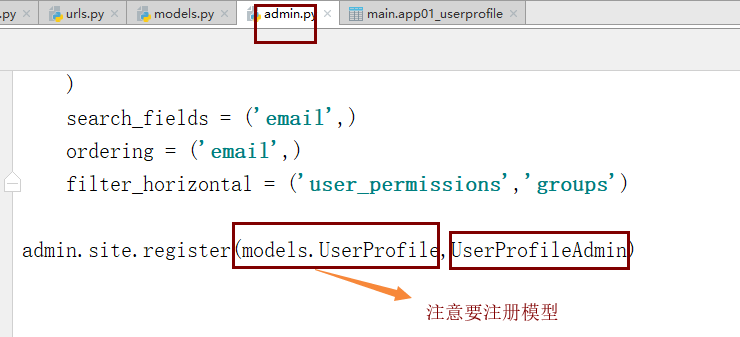
最后在pycharm的命令行生成记录,并同步到数据库
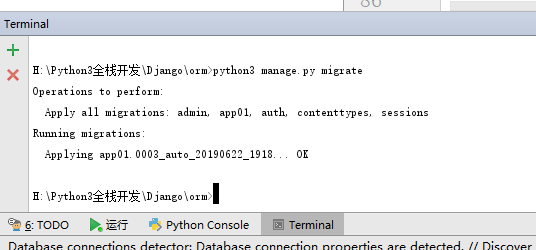
输入命令:python3 manage.py makemigrations
再次输入:python3 manage.py migrate
注意:我这里是python3进入python3交互界面,你的可能是python。根据自己情况而定!
最后一步:创建超级用户

启动django项目后,输入admin进入后台管理:
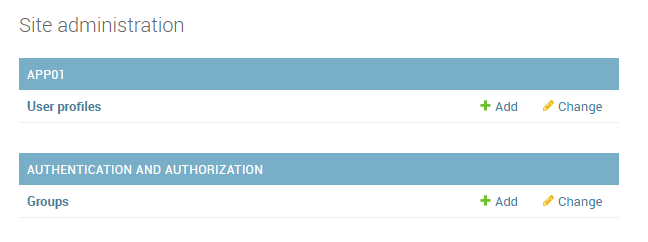


此时,你发现我们的密码是密文,我们必须支持管理员可以在后台修改所有人的密码。
具体步骤如下:
step1
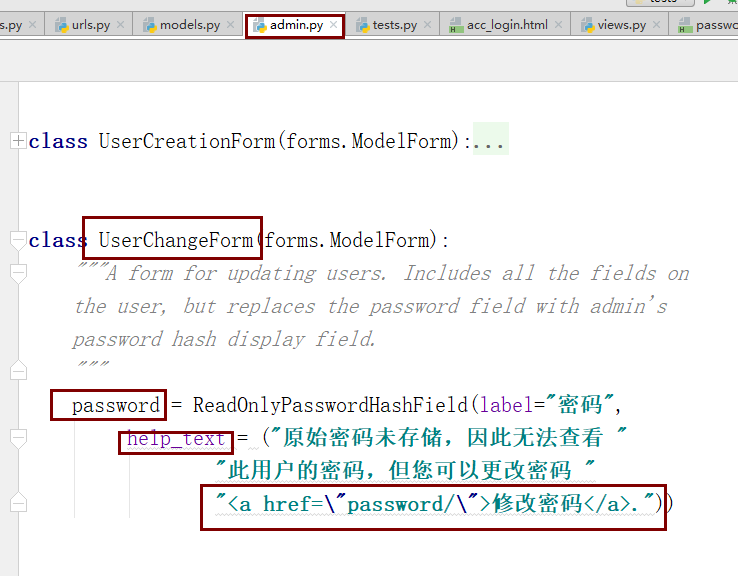
step2
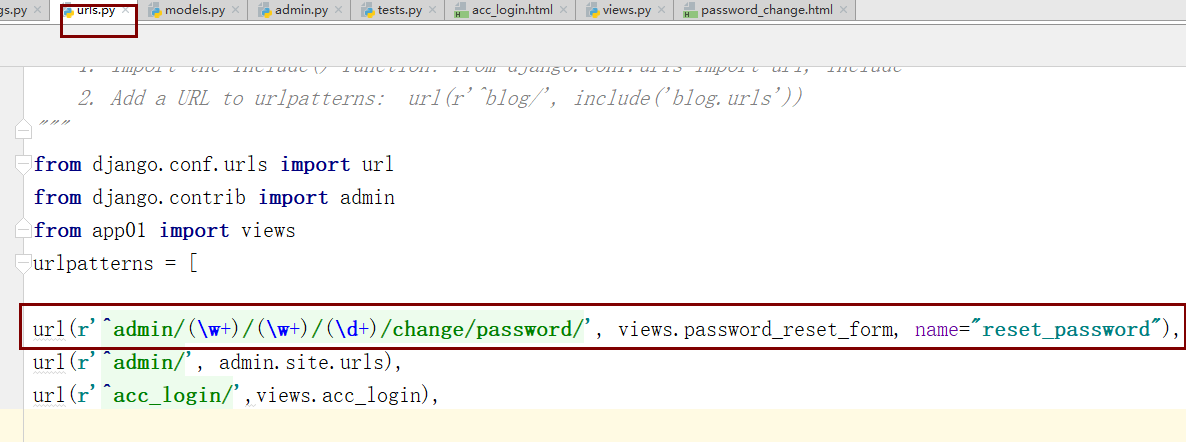
step3
templates/password_change.html
<!DOCTYPE html>
<html lang="en">
<head>
<meta charset="UTF-8">
<title>修改密码</title>
</head>
<body>
<h1>修改密码</h1>
<form action="" method="post">
{% csrf_token %}
<p>
<input type="password" name="pwd1" placeholder="密码">
</p> <p>
<input type="password" name="pwd2" placeholder="确认密码">
</p> <p>
<input type="submit" value="修改">
</p>
</form>
</body>
</html>
app01/views.py
def password_reset_form(request,app_name,table_db_name,user_id):
# 获取被修改对象
user_obj = request.user._meta.model.objects.get(id=user_id)
print("**********:{}".format(user_obj))
can_change_user_password = False
# 管理员修改其他人的密码/管理员修改自己的密码
if request.user.is_superuser or request.user.id == user_obj.id:
print(request.user.is_superuser)
can_change_user_password = True
if can_change_user_password:
if request.method == "GET":
return render(request,"password_change.html")
else:
if request.POST.get("pwd1") != "" and request.POST.get("pwd1") == request.POST.get("pwd2"):
user_obj = User.objects.filter(id=user_obj.id).first()
user_obj.set_password(request.POST.get("pwd2"))
user_obj.save()
print(request.POST.get("pwd2"))
return redirect("/admin/")
else:
return HttpResponse("只有管理员可以修改密码")
此时,我们就实现了管理员可以在后台修改任何用户的密码
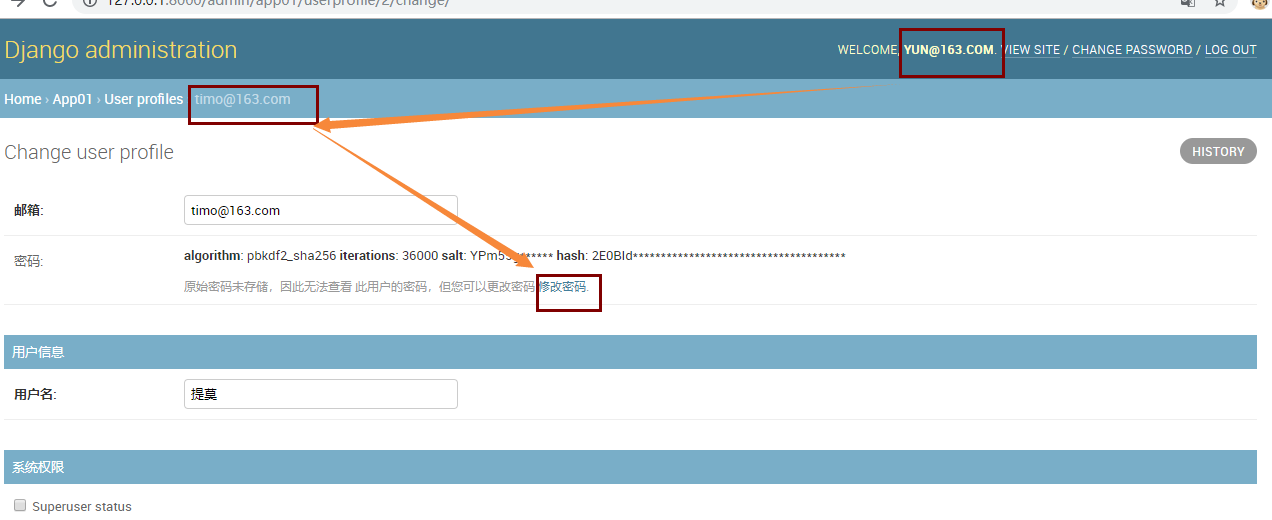

Django自定义认证系统的更多相关文章
- django用户认证系统——拓展 User 模型
Django 用户认证系统提供了一个内置的 User 对象,用于记录用户的用户名,密码等个人信息.对于 Django 内置的 User 模型, 仅包含以下一些主要的属性: username,即用户名 ...
- Django的认证系统
Django自带的用户认证 我们在开发一个网站的时候,无可避免的需要设计实现网站的用户系统.此时我们需要实现包括用户注册.用户登录.用户认证.注销.修改密码等功能,这还真是个麻烦的事情呢. Djang ...
- Django的认证系统—auth模块
Django的认证系统 auth模块的知识点总结: 1. 创建超级用户 python manage.py createsuperuser from django.contrib import auth ...
- django 自定义认证
在Django中自定义身份验证 Django 自带的认证系统足够应付大多数情况,但你或许不打算使用现成的认证系统.定制自己的项目的权限系统需要了解哪些一些关键点,即Django中哪些部分是能够扩展或替 ...
- django用户认证系统——拓展 User 模型2
Django 用户认证系统提供了一个内置的 User 对象,用于记录用户的用户名,密码等个人信息.对于 Django 内置的 User 模型, 仅包含以下一些主要的属性: username,即用户名 ...
- django用户认证系统——基本设置1
网站提供登录.注册等用户认证功能是一个常见的需求.因此,Django 提供了一套功能完整的.灵活的.易于拓展的用户认证系统:django.contrib.auth.在本教程中,我将向你展示 auth ...
- DRF内置认证组件之自定义认证系统
自定义token认证 我们知道,在django项目中不管路由以及对应的视图类是如何写的,都会走到 dispatch 方法,进行路由分发, 在阅读 APIView类中的dispatch 方法的源码中,有 ...
- “Django用户认证系统”学习资料收集
首推追梦人物——Django用户认证系统 待续……
- Django之认证系统
Django之认证系统 cookie和session 1.cookie不属于http协议范围,由于http协议无法保持状态,但实际情况,我们却又需要“保持状态”,因此cookie就是在这样一个场景下诞 ...
随机推荐
- 【Ubuntu】16.04网卡信息配置
①查看操作系统版本信息: ②查看网卡信息 输入ifconfig命令查看网卡信息,下图enp0s25就是网卡名称. ifconfig ③配置网卡文件 注意:不同的linux系统,网卡配置文件是不同的,这 ...
- 纵我不往,知识不来--学习Java第一周心得
暑假第一周,也是开始学习java的第一周. 本周的主要时间花在了小学期的任务上,但也草草开始了java的学习.首先安装好了所需要的软件,然后在网上下载了一份<Java基础笔记>,看了前五章 ...
- Spring+dubbo错误(二)
ERROR [TestContextManager.java:231] Caught exception while allowing TestExecutionListener [org.sprin ...
- DOCKER学习_008:Docker容器的运行最佳实践
一 容器分类 容器按用途大致可分为两类: 服务类容器,如 web server. database等 工具类容器,如cur容器, Iredis-cli容器 通常而言,服务类容器需要长期运行,所以使用 ...
- DEVOPS技术实践_12:创建持续集成的管道
持续集成不仅包含了Jenkins或者相关其它的CI工具,也包含了包含代码如何控制,采用的什么分支策略等.不同的组织可能采用不同的类型的策略来完成CI,策略类型和项目的类型的有很大的关系. 一 分支策略 ...
- 【一起学源码-微服务】Nexflix Eureka 源码十一:EurekaServer自我保护机制竟然有这么多Bug?
前言 前情回顾 上一讲主要讲了服务下线,已经注册中心自动感知宕机的服务. 其实上一讲已经包含了很多EurekaServer自我保护的代码,其中还发现了1.7.x(1.9.x)包含的一些bug,但这些问 ...
- $CF559C\ Gerald\ and\ Fiant\ Chess$ 计数类$DP$
AcWing Description 有个$H$行$W$列的棋盘,里面有$N$个黑色格子,求一个棋子由左上方格子走到右下方格子且不经过黑色格子的方案数. $1<=H,M<=1e5,1< ...
- vux中x-input在安卓手机输入框的删除按钮(@on-click-clear-icon)点击没反应
首先看你自己的的版本好,如果在2.6.9以上,我是在git上找到的解决办法,记录一下,希望可以帮到有需要的小伙伴. 在项目中找 node_modules > vux > x-input & ...
- spring cloud微服务快速教程之(六) 应用监控 spring boot admin
0-前言 当我们发布了微服务后,我们希望对各个应用的各个运行状况进行一个监控:这个时候spring boot admin,就出场了: spring boot admin:是一个监控和管理spring ...
- linux入门系列3--常见的linux远程登陆管理工具
服务器一般是云服务器或者放置在机房,我们日常工作中通过远程连接工具连接到服务器进行操作,这类工具很多(如SecureCRT.XShell.Putty.FinallShell.TeamViewer以及w ...
